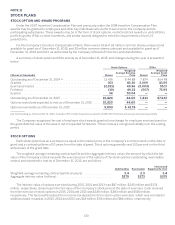American Express 2015 Annual Report Download - page 146
Download and view the complete annual report
Please find page 146 of the 2015 American Express annual report below. You can navigate through the pages in the report by either clicking on the pages listed below, or by using the keyword search tool below to find specific information within the annual report.
In relation to the Company’s credit risk, under the terms of the derivative agreements it has with its various
counterparties, the Company is not required to either immediately settle any outstanding liability balances or post
collateral upon the occurrence of a specified credit risk-related event. Based on the assessment of credit risk of the
Company’s derivative counterparties as of December 31, 2015 and 2014, the Company does not have derivative
positions that warrant credit valuation adjustments.
The Company’s derivatives are carried at fair value on the Consolidated Balance Sheets. The accounting for
changes in fair value depends on the instruments’ intended use and the resulting hedge designation, if any, as
discussed below. Refer to Note 15 for a description of the Company’s methodology for determining the fair value of
derivatives.
The following table summarizes the total fair value, excluding interest accruals, of derivative assets and liabilities
as of December 31:
Other Assets
Fair Value Other Liabilities
Fair Value
(Millions) 2015 2014 2015 2014
Derivatives designated as hedging instruments:
Interest rate contracts
Fair value hedges .......................................................... $ 236 $ 314 $9$4
Foreign exchange contracts
Net investment hedges .................................................... 191 492 57 46
Total derivatives designated as hedging instruments ............................. 427 806 66 50
Derivatives not designated as hedging instruments:
Foreign exchange contracts, including certain embedded derivatives (a) ........... 117 185 135 114
Total derivatives, gross ...................................................... 544 991 201 164
Less: Cash collateral netting (b) ................................................ (155) (158) —(4)
Derivative asset and derivative liability netting (c) ............................. (107) (122) (107) (122)
Total derivatives, net (d) ...................................................... $ 282 $ 711 $94 $38
(a) Includes foreign currency derivatives embedded in certain operating agreements.
(b) Represents the offsetting of derivative instruments and the right to reclaim cash collateral (a receivable) or the obligation to return cash
collateral (a payable) arising from derivative instrument(s) executed with the same counterparty under an enforceable master netting
arrangement. From time to time, the Company also receives non-cash collateral from counterparties in the form of security interests in U.S.
Treasury securities, which reduces the Company’s risk exposure, but does not reduce the net exposure on the Company’s Consolidated
Balance Sheets. The Company had such non-cash collateral, with a fair value of $91 million as of December 31, 2014, none of which was sold or
repledged. The Company did not have any such non-cash collateral as of December 31, 2015. Additionally, the Company posted $149 million
and $114 million as of December 31, 2015 and 2014, respectively, as initial margin on its centrally cleared interest rate swaps; such amounts are
recorded within Other receivables on the Company’s Consolidated Balance Sheets and are not netted against the derivative balances.
(c) Represents the amount of netting of derivative assets and derivative liabilities executed with the same counterparty under an enforceable
master netting arrangement.
(d) The Company has no individually significant derivative counterparties and therefore, no significant risk exposure to any single derivative
counterparty. The total net derivative assets and derivative liabilities are presented within Other assets and Other liabilities on the Company’s
Consolidated Balance Sheets.
A majority of the Company’s derivative assets and liabilities as of December 31, 2015 and 2014, are subject to
master netting agreements with its derivative counterparties. As noted previously, the Company has no derivative
amounts subject to enforceable master netting arrangements that are not offset on the Consolidated Balance Sheets.
DERIVATIVE FINANCIAL INSTRUMENTS THAT QUALIFY FOR HEDGE ACCOUNTING
Derivatives executed for hedge accounting purposes are documented and designated as such when the Company
enters into the contracts. In accordance with its risk management policies, the Company structures its hedges with
terms similar to those of the item being hedged. The Company formally assesses, at inception of the hedge accounting
relationship and on a quarterly basis, whether derivatives designated as hedges are highly effective in offsetting the
fair value or cash flows of the hedged items. These assessments usually are made through the application of a
regression analysis method. If it is determined that a derivative is not highly effective as a hedge, the Company will
discontinue the application of hedge accounting.
135
























